Thermalright Ultima-90: Small Wonder?
by Wesley Fink on August 20, 2007 2:00 AM EST- Posted in
- Cases/Cooling/PSUs
Thermalright Ultima-90
Thermalright specializes in cooling for the enthusiast market. Their CPU coolers are very well known, but they also market chipset, VGA, and RAM coolers, as well as thermal paste. Thermalright has always emphasized their design capabilities in the cooling market, and our test results confirm the excellent performance of their products. They also point to their advanced manufacturing processes, and they are ISO-9000 certified manufacturing plants.
Most hobbyists first heard of Thermalright when their SK-6 cooler appeared in the summer of 2001 and started winning most of the heatsink roundups. Since then Thermalright has become a well-respected name in high-end air cooling. Thermalright produced several well-known heatsinks for the AMD K8 and Pentium 4 sockets, such as the XP-120 and XP-90 heatsinks. You bought the Thermalright heatsink and paired it with the 120mm or 90mm fan of your choice - for low noise or massive air flow or some combination that met your needs. This approach has continued with their current offerings.

Product has been the emphasis at Thermalright, and packaging generally consists of the same-size sturdy brown box with custom foam inserts to protect the cooler. That has not changed with the Ultima-90.
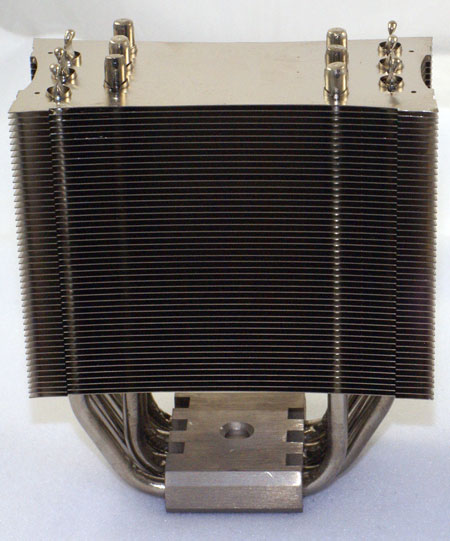
The cooler looks like an Ultra-120 eXtreme that has been on a diet. There are the same six heatpipe loops (12 risers) seen in the eXtreme, but the Ultima-90 body is closer in size to the Ultra-90. The Ultra-90 is 102x45x147, where the Ultima-90 is 115x55x139. That makes the Ultima-90 a little wider and deeper than the Ultra-90, but about 8mm shorter than the Ultra. It is smaller in all dimensions than the top-performing Ultra-120 eXtreme which is 132x63.44x160. Keep in mind that the eXtreme is already one of the smallest of the full heatpipe tower coolers and you will get a good idea of how small the Ultima-90 is relative to other heatpipe towers we have reviewed.
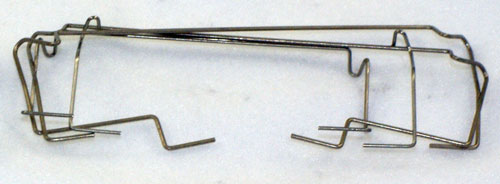
The Ultima-90 is also the first Thermalright we have tested with four sets of fan wire mounting holes. This means with the right fan wires you can mount two fans in a push pull configuration. Also unique is the support for both 120mm or 92mm fans. The slightly wider width provides a solid base for your favorite 120mm fan or a 92mm fan nestles solidly in the fin grooves. Two sets of fan wires are included - one set for mounting 120mm and the other for 92mm.
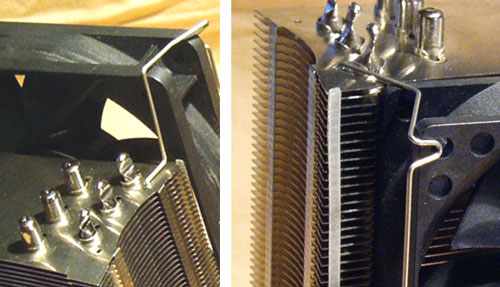
We have complained in past reviews that Thermalright limits the type of fans that can be used by supplying fan wires that would only mount postless fans. Thermalright has clearly been listening, because the new design can mount fans with posts or postless fans. Almost any 120mm or 90mm fan will mount on the new Ultima-90.
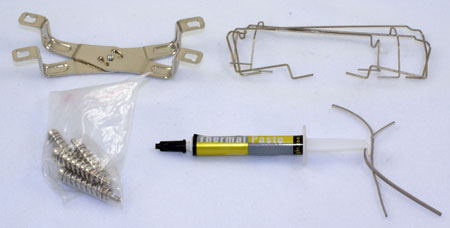
Accessories include a mounting base for under the motherboard and a top plate with spring loaded screws for Intel socket 775 and a clip for AM2 sockets. The mounting kit for AMD 745/939/940 is not included, but it is available as an optional accessory called the "939 Bolt Thru Kit". Thermalright also includes a small tube of premium thermal paste and installation instructions.
Mounting is much like other Thermalright coolers we have reviewed. The motherboard must be removed from the case for Intel 775 and a backplate is positioned through the holes in the motherboard. Thermal paste is applied to the CPU and the 775 holder is passed through the cooler and unfolded. The holder is then attached to the threaded screw holes on the backplate by screwing in the four spring-mounted screws attached to the holder.

The final installation is very secure on Intel socket 775. The Ultima-90 weighs just 460g compared to the 790g of the eXtreme. The lighter weight helps in the feeling of security with the Ultima. The mounted heatsink has no tendency to shift or turn on its axis. Those who worry about the dangling weight of the large heatpipe towers will also be happier with the lower profile and weight that is only about a pound compared to the two pounds seen in many large heatpipe towers.
IMPORTANT: The test kit is a pre-production model. The Ultima-90 is now for sale and performance results have been confirmed with a production Ultima-90 cooler. The final production kit contains mounting parts that are different from the pre-production package. Please check current installation instructions at the Thermalright website for information on the contents of the shipping Ultima-90 kit.
Specifications
Our test system is Intel socket 775, but the Ultima-90 will also mount on the AM2 socket as well. Socket 754/939/940 requires an optional 939 Bolt Thru Kit.
Thermalright does not include fans with their top-line coolers so we selected a top 120mm and a 92mm fan for testing with the Ultima-90. For the 120mm fan we used the excellent Scythe S-FLEX SFF21F tested with the Ultra-120 eXtreme.
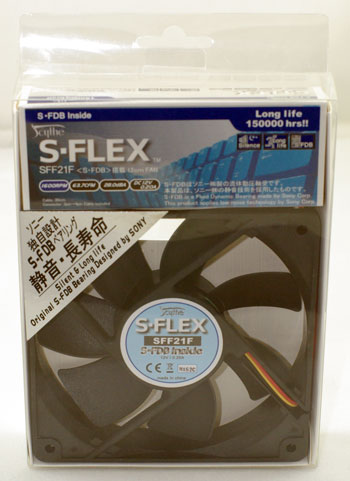
For the 92mm fan we chose the Panasonic Panaflo H1A, which is a very popular fan with cooling enthusiasts looking for high output and low noise with a history of long fan life. We extend our thanks to Frozen CPU for providing the fans for the Ultima-90 tests.
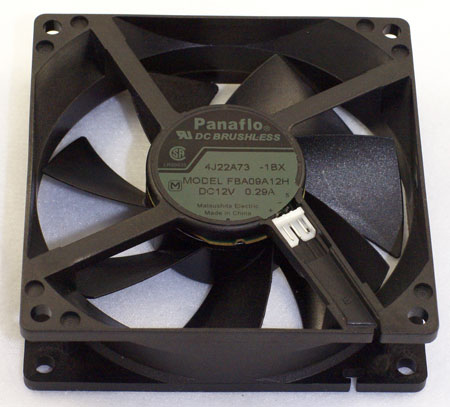
The Ultima-90 is both smaller and lighter than the top-line Ultra-120 eXtreme, but it features the same number of heat pipes in a similar configuration. With the ability to mount either 120mm or 92mm fans, the question is how much the size and weight shrink have compromised performance? It is great that the Ultima-90 is smaller and lighter than any of the top 120mm heatpipe towers, but unless the Ultima-90 performs close to the same level as the best 120 coolers it becomes consideration of whether what you give up justifies the savings in size or money. The Ultima-90, at around $50 retail, is $15 cheaper than the top Ultra-120 eXtreme.
The EVGA 680i is a difficult to fit board due to the copper-finned heatsink and fan cooling the Northbridge. You would expect the smaller and lighter Thermalright Ultima-90 to be an easier fit than the large coolers we have tested with 120mm fans. This is true since the cooler is only 115 mm deep, so that a 120mm fan overlaps each side just slightly. The Ultima-90 fit comfortably on the EVGA 680i. Installation was also an easy task on the ASUS Striker and ASUS Commando, and on the two new P35 boards - the ASUS P5K Deluxe and P5K3 Deluxe. The P5K3 Deluxe will likely become a fit test for any motherboard, since the heatpipes completely circle the CPU socket and connect various cooling heatsinks around the CPU socket.
The height of 139mm is also shorter than most 120 heatpipe towers. This means the Ultima-90 will fit some thin cases that couldn't handle the Thermalright Ultra-120 eXtreme, the Tuniq 120, or the Scythe Infinity. However, the Ultima-90 still cannot be considered a flat cooler. You will need to measure carefully to make sure it will fit your HTPC or rack-mount case
Thermalright specializes in cooling for the enthusiast market. Their CPU coolers are very well known, but they also market chipset, VGA, and RAM coolers, as well as thermal paste. Thermalright has always emphasized their design capabilities in the cooling market, and our test results confirm the excellent performance of their products. They also point to their advanced manufacturing processes, and they are ISO-9000 certified manufacturing plants.
Most hobbyists first heard of Thermalright when their SK-6 cooler appeared in the summer of 2001 and started winning most of the heatsink roundups. Since then Thermalright has become a well-respected name in high-end air cooling. Thermalright produced several well-known heatsinks for the AMD K8 and Pentium 4 sockets, such as the XP-120 and XP-90 heatsinks. You bought the Thermalright heatsink and paired it with the 120mm or 90mm fan of your choice - for low noise or massive air flow or some combination that met your needs. This approach has continued with their current offerings.

Product has been the emphasis at Thermalright, and packaging generally consists of the same-size sturdy brown box with custom foam inserts to protect the cooler. That has not changed with the Ultima-90.

The cooler looks like an Ultra-120 eXtreme that has been on a diet. There are the same six heatpipe loops (12 risers) seen in the eXtreme, but the Ultima-90 body is closer in size to the Ultra-90. The Ultra-90 is 102x45x147, where the Ultima-90 is 115x55x139. That makes the Ultima-90 a little wider and deeper than the Ultra-90, but about 8mm shorter than the Ultra. It is smaller in all dimensions than the top-performing Ultra-120 eXtreme which is 132x63.44x160. Keep in mind that the eXtreme is already one of the smallest of the full heatpipe tower coolers and you will get a good idea of how small the Ultima-90 is relative to other heatpipe towers we have reviewed.

The Ultima-90 is also the first Thermalright we have tested with four sets of fan wire mounting holes. This means with the right fan wires you can mount two fans in a push pull configuration. Also unique is the support for both 120mm or 92mm fans. The slightly wider width provides a solid base for your favorite 120mm fan or a 92mm fan nestles solidly in the fin grooves. Two sets of fan wires are included - one set for mounting 120mm and the other for 92mm.

We have complained in past reviews that Thermalright limits the type of fans that can be used by supplying fan wires that would only mount postless fans. Thermalright has clearly been listening, because the new design can mount fans with posts or postless fans. Almost any 120mm or 90mm fan will mount on the new Ultima-90.

Accessories include a mounting base for under the motherboard and a top plate with spring loaded screws for Intel socket 775 and a clip for AM2 sockets. The mounting kit for AMD 745/939/940 is not included, but it is available as an optional accessory called the "939 Bolt Thru Kit". Thermalright also includes a small tube of premium thermal paste and installation instructions.
Mounting is much like other Thermalright coolers we have reviewed. The motherboard must be removed from the case for Intel 775 and a backplate is positioned through the holes in the motherboard. Thermal paste is applied to the CPU and the 775 holder is passed through the cooler and unfolded. The holder is then attached to the threaded screw holes on the backplate by screwing in the four spring-mounted screws attached to the holder.

The final installation is very secure on Intel socket 775. The Ultima-90 weighs just 460g compared to the 790g of the eXtreme. The lighter weight helps in the feeling of security with the Ultima. The mounted heatsink has no tendency to shift or turn on its axis. Those who worry about the dangling weight of the large heatpipe towers will also be happier with the lower profile and weight that is only about a pound compared to the two pounds seen in many large heatpipe towers.
IMPORTANT: The test kit is a pre-production model. The Ultima-90 is now for sale and performance results have been confirmed with a production Ultima-90 cooler. The final production kit contains mounting parts that are different from the pre-production package. Please check current installation instructions at the Thermalright website for information on the contents of the shipping Ultima-90 kit.
Specifications
Our test system is Intel socket 775, but the Ultima-90 will also mount on the AM2 socket as well. Socket 754/939/940 requires an optional 939 Bolt Thru Kit.
| Thermalright Ultima-90 Specifications | |
| Heatsink | |
| Dimensions | 115(W) X55 (D) X 139(H)mm |
| Weight | 460g |
| Material | Nickel-plated Copper Aluminum |
| Heatpipes | Six looped (twelve risers) Plated Copper Heatpipes |
| Fan Configuration | Supports 120mm or 92mm fans |
| Fan Types Supported | Any Fan - Post or Postless |
Thermalright does not include fans with their top-line coolers so we selected a top 120mm and a 92mm fan for testing with the Ultima-90. For the 120mm fan we used the excellent Scythe S-FLEX SFF21F tested with the Ultra-120 eXtreme.
| 120mm Fan Specifications | |
| Model | Scythe S-Flex SFF21F |
| Fan Size | 120mm x 120mm x 25mm |
| Fan Type | Sony Fluid Dynamic Bearing |
| Maximum Fan Speed | 1600 RPM |
| Maximum Noise Level | 28.0 dB(A) |
| Maximum Airflow | 63.7 CFM |
| Fan Life | 150,000 Hours (vs. 50,000 hours for ball bearing) |
| Weight | 180g (Fan Only) |

For the 92mm fan we chose the Panasonic Panaflo H1A, which is a very popular fan with cooling enthusiasts looking for high output and low noise with a history of long fan life. We extend our thanks to Frozen CPU for providing the fans for the Ultima-90 tests.
| 92mm Fan Specifications | |
| Model | Panaflo H1A 92mm (BX) with RPM Sensor |
| Fan Size | 92mm x 92mm x 25mm |
| Fan Type | Hydro Wave (Fluid) Bearing |
| Maximum Fan Speed | 2850 RPM |
| Maximum Noise Level | 35.0 db |
| Maximum Airflow | 56.8 CFM |

The Ultima-90 is both smaller and lighter than the top-line Ultra-120 eXtreme, but it features the same number of heat pipes in a similar configuration. With the ability to mount either 120mm or 92mm fans, the question is how much the size and weight shrink have compromised performance? It is great that the Ultima-90 is smaller and lighter than any of the top 120mm heatpipe towers, but unless the Ultima-90 performs close to the same level as the best 120 coolers it becomes consideration of whether what you give up justifies the savings in size or money. The Ultima-90, at around $50 retail, is $15 cheaper than the top Ultra-120 eXtreme.
The EVGA 680i is a difficult to fit board due to the copper-finned heatsink and fan cooling the Northbridge. You would expect the smaller and lighter Thermalright Ultima-90 to be an easier fit than the large coolers we have tested with 120mm fans. This is true since the cooler is only 115 mm deep, so that a 120mm fan overlaps each side just slightly. The Ultima-90 fit comfortably on the EVGA 680i. Installation was also an easy task on the ASUS Striker and ASUS Commando, and on the two new P35 boards - the ASUS P5K Deluxe and P5K3 Deluxe. The P5K3 Deluxe will likely become a fit test for any motherboard, since the heatpipes completely circle the CPU socket and connect various cooling heatsinks around the CPU socket.
The height of 139mm is also shorter than most 120 heatpipe towers. This means the Ultima-90 will fit some thin cases that couldn't handle the Thermalright Ultra-120 eXtreme, the Tuniq 120, or the Scythe Infinity. However, the Ultima-90 still cannot be considered a flat cooler. You will need to measure carefully to make sure it will fit your HTPC or rack-mount case










38 Comments
View All Comments
Wesley Fink - Monday, August 20, 2007 - link
The performance of the stock Intel Retail cooler also needs to be put in perspective. In our testing the Intel Retail HSF is stable to 3.73GHz at 1.50V. That translates into about 137W with an X6800 CPU.While early Intel Retail 775 coolers were very noisy, stock coolers since late Presller and through Core2 have been very quiet, as you can see in our noise measurements in reviews.
With a stock cooler performing this well, we think a cooler HAS to provide performance better than Intel Stock to persuade you to buy it. We could argue using your logic that the difference between the Intel stock of 3.73GHz and the top 3.94GHz is only 200 megahertz and so it is minor. The wattage difference, however, is between 137W and 166W, which is a significant difference in the ability of coolers to dssipate heat.
ssiu - Monday, August 20, 2007 - link
I have a serious question regarding this. 3.73Ghz is perfectly fine with me and I don't care for another 200Mhz. The louder noise of stock cooler is also okay with me. So that leaves the temperature difference of 71C for stock cooler versus (43C for Ultra-120 eXtreme, 47C for Ultima-90, 59C for NinjaB, 62C for Infinity, etc.) Does the stock cooler's higher temperature make the CPU die prematurely? Or is it a case of "the CPU is designed to withstand 71C; at 3.73Ghz, 71C may make it last 5 years instead of 10 years at 43C, but even at 71C it will become obsolete (too slow) before it will die"?Wesley Fink - Monday, August 20, 2007 - link
Intel shows a maximum recommended temp of 60.4C at 75W (stock) for the X6800 in their thermal design document at ftp://download.intel.com/design/processor/datashts...">ftp://download.intel.com/design/processor/datashts... However, 3.83 Ghz is about 137W and we really don't know the recommendations at these higher frequencies since they represent overclocks.It would seem reasonable to aim for lower than the max recommended temperature at stock speed if you are aiming for longevity of the CPU. That cahart can be found on p.85 of the Intel PDF linked above.
Wesley Fink - Monday, August 20, 2007 - link
Correction - 3.73GHz at 1.5V is about 135W - which is the max stable speed with the Intel stock HSF. Sorry for the typo.Jedi2155 - Monday, August 20, 2007 - link
To Coolerman:I had the Tuniq 120 for about 6 months on my E6600 setup, and although it was a great cooler and signifcantly cheaper than the Ultra 120 Extreme, it just isn't as good when all things are considered (size, noise levels, fan options) and the Ultra 120 extreme is worth the price difference IMO. The size made installation ever so much easier than the Tuniq and improvement in cooling (even with a cheap $7 thermaltake fan) was significant (went from 80 C Intel TAT to around 70 C).
I definitely think that you should recategorize the coolers, but instead of temperature, how about price range or probably best category SIZE.
I've had a number of issues during builds for friends, where the a certain cooler wouldn't fit (like a Tuniq 120 or the Ultra 120 Extreme) fit inside a case without significant modification (with a pair of pliers and remove a good section of the case).
That should help us decide better than just pure temperatures and overclock speed.
CZroe - Monday, August 20, 2007 - link
I think that sorting by value/prices is a bad idea. Have you looked for the actual prices? Anandtech's reported suggested prices and "actual" market prices have been FAR lower than I've been able to find in each cooler that interested me. I eventually just settled on the Ultra-120 Extreme and the same fan from Newegg and paid FAR too much.Perhaps the observed difference is because they keep getting price results for similar models (which complicated my own searching) or the only places that still carry some of these still have them because they always overcharged.
tom0099 - Friday, August 6, 2021 - link
http://google.com">googletom0099 - Friday, August 6, 2021 - link
<a href="https://google.com">google</a>